Lixin Su
TP-RAG: Benchmarking Retrieval-Augmented Large Language Model Agents for Spatiotemporal-Aware Travel Planning
Apr 11, 2025Abstract:Large language models (LLMs) have shown promise in automating travel planning, yet they often fall short in addressing nuanced spatiotemporal rationality. While existing benchmarks focus on basic plan validity, they neglect critical aspects such as route efficiency, POI appeal, and real-time adaptability. This paper introduces TP-RAG, the first benchmark tailored for retrieval-augmented, spatiotemporal-aware travel planning. Our dataset includes 2,348 real-world travel queries, 85,575 fine-grain annotated POIs, and 18,784 high-quality travel trajectory references sourced from online tourist documents, enabling dynamic and context-aware planning. Through extensive experiments, we reveal that integrating reference trajectories significantly improves spatial efficiency and POI rationality of the travel plan, while challenges persist in universality and robustness due to conflicting references and noisy data. To address these issues, we propose EvoRAG, an evolutionary framework that potently synergizes diverse retrieved trajectories with LLMs' intrinsic reasoning. EvoRAG achieves state-of-the-art performance, improving spatiotemporal compliance and reducing commonsense violation compared to ground-up and retrieval-augmented baselines. Our work underscores the potential of hybridizing Web knowledge with LLM-driven optimization, paving the way for more reliable and adaptive travel planning agents.
CoRanking: Collaborative Ranking with Small and Large Ranking Agents
Apr 01, 2025Abstract:Large Language Models (LLMs) have demonstrated superior listwise ranking performance. However, their superior performance often relies on large-scale parameters (\eg, GPT-4) and a repetitive sliding window process, which introduces significant efficiency challenges. In this paper, we propose \textbf{CoRanking}, a novel collaborative ranking framework that combines small and large ranking models for efficient and effective ranking. CoRanking first employs a small-size reranker to pre-rank all the candidate passages, bringing relevant ones to the top part of the list (\eg, top-20). Then, the LLM listwise reranker is applied to only rerank these top-ranked passages instead of the whole list, substantially enhancing overall ranking efficiency. Although more efficient, previous studies have revealed that the LLM listwise reranker have significant positional biases on the order of input passages. Directly feed the top-ranked passages from small reranker may result in the sub-optimal performance of LLM listwise reranker. To alleviate this problem, we introduce a passage order adjuster trained via reinforcement learning, which reorders the top passages from the small reranker to align with the LLM's preferences of passage order. Extensive experiments on three IR benchmarks demonstrate that CoRanking significantly improves efficiency (reducing ranking latency by about 70\%) while achieving even better effectiveness compared to using only the LLM listwise reranker.
Cross-model Control: Improving Multiple Large Language Models in One-time Training
Oct 23, 2024



Abstract:The number of large language models (LLMs) with varying parameter scales and vocabularies is increasing. While they deliver powerful performance, they also face a set of common optimization needs to meet specific requirements or standards, such as instruction following or avoiding the output of sensitive information from the real world. However, how to reuse the fine-tuning outcomes of one model to other models to reduce training costs remains a challenge. To bridge this gap, we introduce Cross-model Control (CMC), a method that improves multiple LLMs in one-time training with a portable tiny language model. Specifically, we have observed that the logit shift before and after fine-tuning is remarkably similar across different models. Based on this insight, we incorporate a tiny language model with a minimal number of parameters. By training alongside a frozen template LLM, the tiny model gains the capability to alter the logits output by the LLMs. To make this tiny language model applicable to models with different vocabularies, we propose a novel token mapping strategy named PM-MinED. We have conducted extensive experiments on instruction tuning and unlearning tasks, demonstrating the effectiveness of CMC. Our code is available at https://github.com/wujwyi/CMC.
JAILJUDGE: A Comprehensive Jailbreak Judge Benchmark with Multi-Agent Enhanced Explanation Evaluation Framework
Oct 11, 2024



Abstract:Despite advancements in enhancing LLM safety against jailbreak attacks, evaluating LLM defenses remains a challenge, with current methods often lacking explainability and generalization to complex scenarios, leading to incomplete assessments (e.g., direct judgment without reasoning, low F1 score of GPT-4 in complex cases, bias in multilingual scenarios). To address this, we present JAILJUDGE, a comprehensive benchmark featuring diverse risk scenarios, including synthetic, adversarial, in-the-wild, and multilingual prompts, along with high-quality human-annotated datasets. The JAILJUDGE dataset includes over 35k+ instruction-tune data with reasoning explainability and JAILJUDGETEST, a 4.5k+ labeled set for risk scenarios, and a 6k+ multilingual set across ten languages. To enhance evaluation with explicit reasoning, we propose the JailJudge MultiAgent framework, which enables explainable, fine-grained scoring (1 to 10). This framework supports the construction of instruction-tuning ground truth and facilitates the development of JAILJUDGE Guard, an end-to-end judge model that provides reasoning and eliminates API costs. Additionally, we introduce JailBoost, an attacker-agnostic attack enhancer, and GuardShield, a moderation defense, both leveraging JAILJUDGE Guard. Our experiments demonstrate the state-of-the-art performance of JailJudge methods (JailJudge MultiAgent, JAILJUDGE Guard) across diverse models (e.g., GPT-4, Llama-Guard) and zero-shot scenarios. JailBoost and GuardShield significantly improve jailbreak attack and defense tasks under zero-shot settings, with JailBoost enhancing performance by 29.24% and GuardShield reducing defense ASR from 40.46% to 0.15%.
FltLM: An Intergrated Long-Context Large Language Model for Effective Context Filtering and Understanding
Oct 09, 2024
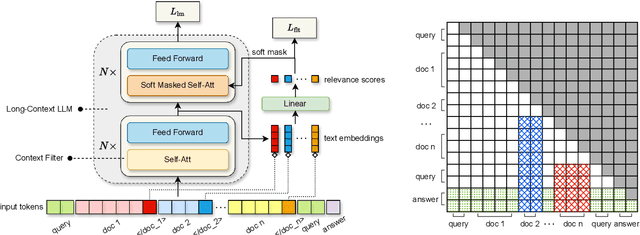


Abstract:The development of Long-Context Large Language Models (LLMs) has markedly advanced natural language processing by facilitating the process of textual data across long documents and multiple corpora. However, Long-Context LLMs still face two critical challenges: The lost in the middle phenomenon, where crucial middle-context information is likely to be missed, and the distraction issue that the models lose focus due to overly extended contexts. To address these challenges, we propose the Context Filtering Language Model (FltLM), a novel integrated Long-Context LLM which enhances the ability of the model on multi-document question-answering (QA) tasks. Specifically, FltLM innovatively incorporates a context filter with a soft mask mechanism, identifying and dynamically excluding irrelevant content to concentrate on pertinent information for better comprehension and reasoning. Our approach not only mitigates these two challenges, but also enables the model to operate conveniently in a single forward pass. Experimental results demonstrate that FltLM significantly outperforms supervised fine-tuning and retrieval-based methods in complex QA scenarios, suggesting a promising solution for more accurate and reliable long-context natural language understanding applications.
GenCRF: Generative Clustering and Reformulation Framework for Enhanced Intent-Driven Information Retrieval
Sep 17, 2024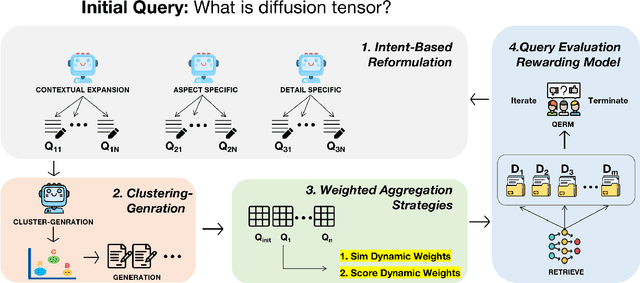
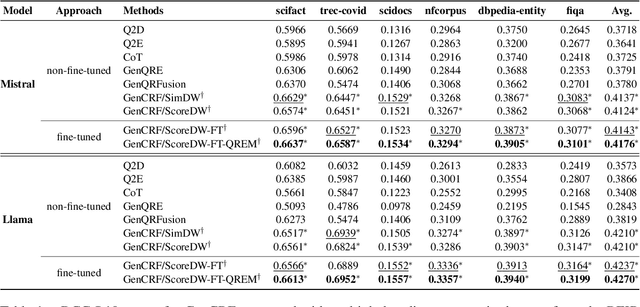
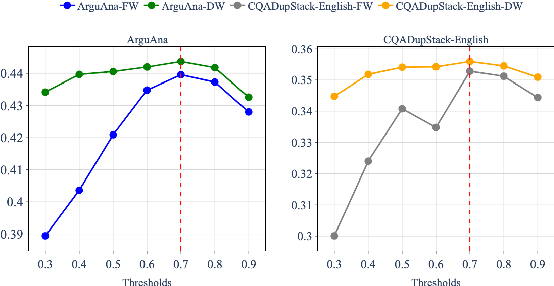
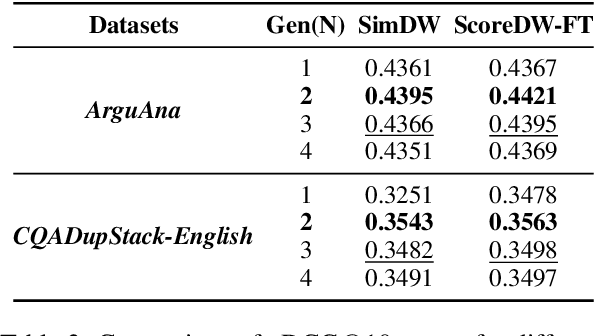
Abstract:Query reformulation is a well-known problem in Information Retrieval (IR) aimed at enhancing single search successful completion rate by automatically modifying user's input query. Recent methods leverage Large Language Models (LLMs) to improve query reformulation, but often generate limited and redundant expansions, potentially constraining their effectiveness in capturing diverse intents. In this paper, we propose GenCRF: a Generative Clustering and Reformulation Framework to capture diverse intentions adaptively based on multiple differentiated, well-generated queries in the retrieval phase for the first time. GenCRF leverages LLMs to generate variable queries from the initial query using customized prompts, then clusters them into groups to distinctly represent diverse intents. Furthermore, the framework explores to combine diverse intents query with innovative weighted aggregation strategies to optimize retrieval performance and crucially integrates a novel Query Evaluation Rewarding Model (QERM) to refine the process through feedback loops. Empirical experiments on the BEIR benchmark demonstrate that GenCRF achieves state-of-the-art performance, surpassing previous query reformulation SOTAs by up to 12% on nDCG@10. These techniques can be adapted to various LLMs, significantly boosting retriever performance and advancing the field of Information Retrieval.
Text-Video Retrieval via Variational Multi-Modal Hypergraph Networks
Jan 06, 2024Abstract:Text-video retrieval is a challenging task that aims to identify relevant videos given textual queries. Compared to conventional textual retrieval, the main obstacle for text-video retrieval is the semantic gap between the textual nature of queries and the visual richness of video content. Previous works primarily focus on aligning the query and the video by finely aggregating word-frame matching signals. Inspired by the human cognitive process of modularly judging the relevance between text and video, the judgment needs high-order matching signal due to the consecutive and complex nature of video contents. In this paper, we propose chunk-level text-video matching, where the query chunks are extracted to describe a specific retrieval unit, and the video chunks are segmented into distinct clips from videos. We formulate the chunk-level matching as n-ary correlations modeling between words of the query and frames of the video and introduce a multi-modal hypergraph for n-ary correlation modeling. By representing textual units and video frames as nodes and using hyperedges to depict their relationships, a multi-modal hypergraph is constructed. In this way, the query and the video can be aligned in a high-order semantic space. In addition, to enhance the model's generalization ability, the extracted features are fed into a variational inference component for computation, obtaining the variational representation under the Gaussian distribution. The incorporation of hypergraphs and variational inference allows our model to capture complex, n-ary interactions among textual and visual contents. Experimental results demonstrate that our proposed method achieves state-of-the-art performance on the text-video retrieval task.
Agent4Ranking: Semantic Robust Ranking via Personalized Query Rewriting Using Multi-agent LLM
Dec 24, 2023Abstract:Search engines are crucial as they provide an efficient and easy way to access vast amounts of information on the internet for diverse information needs. User queries, even with a specific need, can differ significantly. Prior research has explored the resilience of ranking models against typical query variations like paraphrasing, misspellings, and order changes. Yet, these works overlook how diverse demographics uniquely formulate identical queries. For instance, older individuals tend to construct queries more naturally and in varied order compared to other groups. This demographic diversity necessitates enhancing the adaptability of ranking models to diverse query formulations. To this end, in this paper, we propose a framework that integrates a novel rewriting pipeline that rewrites queries from various demographic perspectives and a novel framework to enhance ranking robustness. To be specific, we use Chain of Thought (CoT) technology to utilize Large Language Models (LLMs) as agents to emulate various demographic profiles, then use them for efficient query rewriting, and we innovate a robust Multi-gate Mixture of Experts (MMoE) architecture coupled with a hybrid loss function, collectively strengthening the ranking models' robustness. Our extensive experimentation on both public and industrial datasets assesses the efficacy of our query rewriting approach and the enhanced accuracy and robustness of the ranking model. The findings highlight the sophistication and effectiveness of our proposed model.
LLMRec: Large Language Models with Graph Augmentation for Recommendation
Nov 17, 2023Abstract:The problem of data sparsity has long been a challenge in recommendation systems, and previous studies have attempted to address this issue by incorporating side information. However, this approach often introduces side effects such as noise, availability issues, and low data quality, which in turn hinder the accurate modeling of user preferences and adversely impact recommendation performance. In light of the recent advancements in large language models (LLMs), which possess extensive knowledge bases and strong reasoning capabilities, we propose a novel framework called LLMRec that enhances recommender systems by employing three simple yet effective LLM-based graph augmentation strategies. Our approach leverages the rich content available within online platforms (e.g., Netflix, MovieLens) to augment the interaction graph in three ways: (i) reinforcing user-item interaction egde, (ii) enhancing the understanding of item node attributes, and (iii) conducting user node profiling, intuitively from the natural language perspective. By employing these strategies, we address the challenges posed by sparse implicit feedback and low-quality side information in recommenders. Besides, to ensure the quality of the augmentation, we develop a denoised data robustification mechanism that includes techniques of noisy implicit feedback pruning and MAE-based feature enhancement that help refine the augmented data and improve its reliability. Furthermore, we provide theoretical analysis to support the effectiveness of LLMRec and clarify the benefits of our method in facilitating model optimization. Experimental results on benchmark datasets demonstrate the superiority of our LLM-based augmentation approach over state-of-the-art techniques. To ensure reproducibility, we have made our code and augmented data publicly available at: https://github.com/HKUDS/LLMRec.git
Representation Learning with Large Language Models for Recommendation
Oct 24, 2023
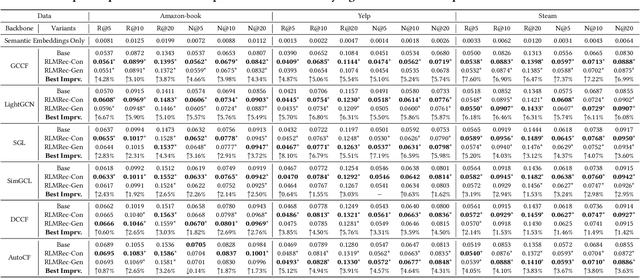
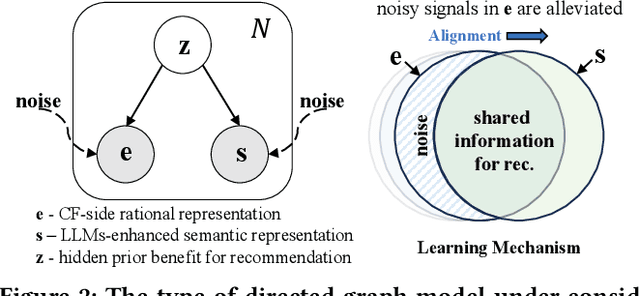
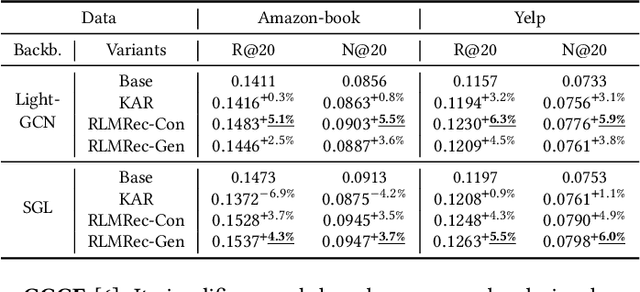
Abstract:Recommender systems have seen significant advancements with the influence of deep learning and graph neural networks, particularly in capturing complex user-item relationships. However, these graph-based recommenders heavily depend on ID-based data, potentially disregarding valuable textual information associated with users and items, resulting in less informative learned representations. Moreover, the utilization of implicit feedback data introduces potential noise and bias, posing challenges for the effectiveness of user preference learning. While the integration of large language models (LLMs) into traditional ID-based recommenders has gained attention, challenges such as scalability issues, limitations in text-only reliance, and prompt input constraints need to be addressed for effective implementation in practical recommender systems. To address these challenges, we propose a model-agnostic framework RLMRec that aims to enhance existing recommenders with LLM-empowered representation learning. It proposes a recommendation paradigm that integrates representation learning with LLMs to capture intricate semantic aspects of user behaviors and preferences. RLMRec incorporates auxiliary textual signals, develops a user/item profiling paradigm empowered by LLMs, and aligns the semantic space of LLMs with the representation space of collaborative relational signals through a cross-view alignment framework. This work further establish a theoretical foundation demonstrating that incorporating textual signals through mutual information maximization enhances the quality of representations. In our evaluation, we integrate RLMRec with state-of-the-art recommender models, while also analyzing its efficiency and robustness to noise data. Our implementation codes are available at https://github.com/HKUDS/RLMRec.
 Add to Chrome
Add to Chrome Add to Firefox
Add to Firefox Add to Edge
Add to Edge